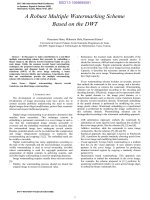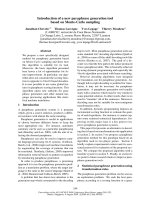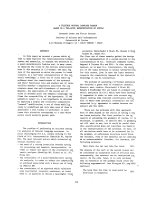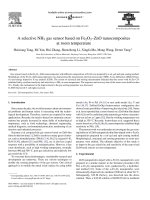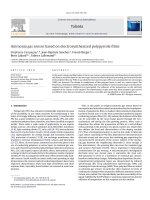- Trang chủ >>
- Khoa Học Tự Nhiên >>
- Vật lý
a selective nh3 gas sensor based on fe2o3–zno nanocomposites at room temperature
Bạn đang xem bản rút gọn của tài liệu. Xem và tải ngay bản đầy đủ của tài liệu tại đây (442.2 KB, 6 trang )
Sensors and Actuators B 114 (2006) 910–915
A selective NH
3
gas sensor based on Fe
2
O
3
–ZnO nanocomposites
at room temperature
Huixiang Tang, Mi Yan, Hui Zhang, Shenzhong Li, Xingfa Ma, Mang Wang, Deren Yang
∗
State Key Laboratory of Silicon Materials, Zhejiang University, Hangzhou 310027, PR China
Received 16 April 2005; received in revised form 25 August 2005; accepted 26 August 2005
Available online 19 October 2005
Abstract
Gas sensors based on the Fe
2
O
3
–ZnO nanocomposites with different compositions of Fe:Zn was prepared by a sol–gel and spin-coating method.
Morphology of the Fe
2
O
3
–ZnO nanocomposites was characterized by transmission electron microscopy (TEM), X-ray diffraction (XRD, D/max-
rA) and energy dispersive X-ray analysis (EDX). The results of electrical and sensing measurement indicated that the sensor with Fe:Zn= 2%
exhibited fairly excellent sensitivity and selectivity to NH
3
at room temperature. The response and recovery time of the sensor were both less than
20 s. Finally, the mechanism for the improvement in the gas sensing properties was discussed.
© 2005 Elsevier B.V. All rights reserved.
Keywords: ZnO nanoparticles; Fe
2
O
3
; Gas sensor; NH
3
1. Introduction
Since many decades, the world awareness about environmen-
tal problems and human safety is increasing with the techno-
logical development. Therefore, sensors are required for many
applications. Recently, the need to detect low ammonia concen-
trations has greatly increased in many fields of technological
importance, such as food technology, chemical engineering,
medical diagnosis, environmental protection, monitoring of car
interiors and industrial processes.
Seiyama et al. proposed the gas sensors based on ZnO thin
films for the first time [1]. ZnO is sensitive to many gases of inter-
est, such as trimethylamine (TMA) [2–4],H
2
[5], oxygen [6–8],
H
2
O [9,10], ethanol [11] and NH
3
[12], etc. It also has a rapid
response with a possibility of miniaturization. However, it has
some drawbacks, such as high working temperature, normally
between 400 and 500
◦
C, poor gas selectivity and relatively low
gas sensitivity [13].
To overcome these disadvantages, considerable research and
development are underway. There are various techniques to
modify the sensing properties of the gas sensors. One critical
approach is to modify the metal oxide surface by using noble
∗
Corresponding author. Tel.: +86 571 8795 1667; fax: +86 571 8795 2322.
E-mail address: (D. Yang).
metals (Au, Pt or Pd) [14,15] or rare earth metals (La, Y and
Ce) [16,17]. ZnO(n)/CuO(p) heterocontact configuration also
showed some possibility of improving theselectivity [18]. Nanto
et al. have reported that a sensor based on a ZnO thin film doped
with Al, In or Ga could detect the ammonia gas whose concentra-
tion was as low as 1 ppm [12]. But the working temperature was
as high as 350
◦
C. Recently, Ivanovskaya et al. suggested that a
sensor based on ␣-Fe
2
O
3
/In
2
O
3
nanocomposites exhibited high
sensitivity to NO
2
[19].
The present work was undertaken to investigate the gas sens-
ing behavior of ZnO nanoparticle thin films doped with ␣-Fe
2
O
3
nanoparticles prepared by a sol–gel and spin-coating method.
Morphological, structural and sensing properties at room tem-
perature were studied. The ultimate objective of this study is
to improve the gas selectivity and sensitivity of the nano-sized
ZnO-based sensors at room temperature.
2. Experimental
ZnO nanoparticles doped with ␣-Fe
2
O
3
nanoparticles were
prepared in a similar manner to the literature procedure [20].
The ␣-Fe
2
O
3
nanoparticles were synthesized by a hydrother-
mal method [21]. Some of the ␣-Fe
2
O
3
nanoparticles were
ultrasonically dispersed into methanol (200 ml) at about 60
◦
C.
Subsequently, 0.01 M Zn(Ac)
2
was dissolved into the above
solution. Then, a 0.03 M solution of KOH (65 ml) in methanol
0925-4005/$ – see front matter © 2005 Elsevier B.V. All rights reserved.
doi:10.1016/j.snb.2005.08.010
H. Tang et al. / Sensors and Actuators B 114 (2006) 910–915 911
was added dropwise. The reaction mixture was stirred for 2 h.
The resulting solution was concentrated by the evaporation of
the solvent. The resulting white product was centrifugalized,
washed with deionized water and ethanol to remove the ions
possibly remaining in the final product. The ZnO nanoparticles
doped with ␣-Fe
2
O
3
nanoparticles with different compositions
(molar ratio) of Fe:Zn being 0, 1, 2, 3 and 4% were prepared.
Finally, five ZnO nanoparticle solutions were obtained, labeled
as sample 0, 1, 2, 3 and 4, respectively. The obtained samples
were characterized by transmission electron microscopy (TEM),
which was performed with a JEM 200 CX microscope operated
at 160 kV. For X-ray diffraction (XRD) (D/max-rA) and energy
dispersive X-ray analysis (EDX) (Phoenix) measurement, pow-
der samples were used, which were prepared by annealing the
final precipitates at 200
◦
C for 3 h.
Interdigitated Au electrodes were obtained by metal deposi-
tion on glass substrates. The final precipitate was redispersible in
ethanol. The Fe
2
O
3
–ZnO nanocomposite films were fabricated
on the top of the Au electrodes by spin-coating, followed by
annealing at 200
◦
C for 3 h before electrical and sensing mea-
surement. Gas sensing behavior of the ZnO nanosensors was
measured at room temperature by using the Keithley 236 Source
Measure Unit. The chamber was purged with N
2
until a steady
baseline of the sensor resistance was reached. Then, the test
vapor was injected at a fixed concentration of 0.4 ppm in N
2
.
In general, the dc voltage was fixed at 10 V, and the changes of
current with time were recorded. The sensor response is given
here as the current ratio I
g
/I
a
, where I
g
and I
a
are the current
across the sensor in the test gas and in air, respectively [22,23].
The response-recovery time of the sensor is defined as the time
needed to reach 90% of the original resistance.
3. Results
3.1. Morphology of Fe
2
O
3
–ZnO nanocomposites
Fig. 1 shows TEM images of the Fe
2
O
3
–ZnO nanocompos-
ites with different compositions of Fe:Zn. Morphology of the
pure ␣-Fe
2
O
3
prepared by a hydrothermal method was nanopar-
ticles (Fig. 1a). Size of the nanoparticles was about 10 nm.
When 1% Fe
2
O
3
(molar ratio) nanoparticles (sample 1) were
doped into the ZnO nanoparticles, the morphology of the result-
ing sample was similar to that of the pure ␣-Fe
2
O
3
(Fig. 1b).
It is obvious that the prepared nanoparticles were crystalline
Fig. 1. TEM images of the ZnO–Fe
2
O
3
nanocomposites with different compositions (molar ratios) of Fe:Zn: (a) pure ␣-Fe
2
O
3
nanoparticles; (b) sample 1, inset is
the selected area electron diffraction (SAED) pattern of the particles; (c) sample 2; (d) sample 3; (e) sample 4, inset is the SAED pattern of the nanorods.
912 H. Tang et al. / Sensors and Actuators B 114 (2006) 910–915
Fig. 2. X-ray diffraction patternsof the ZnO–Fe
2
O
3
nanocomposites with differ-
ent compositions of Fe:Zn. All the diffraction peaks could be indexed according
to hexagonal structure ZnO.
from the inset of Fig. 1b. The morphology of sample 2 was still
nanoparticles and the size was about 10 nm (Fig. 1c). However,
a few short nanorods and nanoparticles co-exited in sample 3
(Fig. 1d). Almost only nanorods exited in sample 4 (Fig. 1e).
These nanorods were still crystalline (inset of Fig. 1e). The
growth mechanism of the nanorods was put forward based on the
above results. It may be the fact that the added Fe
2
O
3
nanopar-
ticles promoted the growth of ZnO nanoparticles as the seeds.
Then, those particles aggregated along one direction and formed
the ZnO nanorods.
3.2. Structural and compositional characterization
Fig. 2 shows the X-ray diffraction patterns of the Fe
2
O
3
–ZnO
nanocomposites with different compositions of Fe:Zn. All the
reflections in the XRD patterns can be indexed to the hexag-
onal structure ZnO with lattice constants of a = 0.3250 nm and
c = 0.5207 nm (JCPDS, 79–2205). No Fe
2
O
3
phase was detected
according to the XRD patterns. It can be concluded that the crys-
tallization is relatively poor when the composition of Fe is 2%.
Fig. 3 shows the image of EDX and composition of sample 4.
Al and Si elements came from the substrates (glass). Fe, O and
Zn elements belonged to the sample. It was calculated that the
composition results were almost consistent with the molar ratio
of ZnO and Fe
2
O
3
from the composition table. Therefore, the
nanorods in sample 4 (Fig. 1e) belonged to ZnO nanorods.
3.3. Selectivity of gas sensors based on Fe
2
O
3
–ZnO
nanocomposites
Fig. 4 shows the selectivity of the gas sensor based on pure
ZnO nanoparticle. The sensor was exposed to TMA, ethanol,
methanol, NH
3
and HCl of the same concentration level of
0.4 ppm at room temperature. From the plots, it can be deduced
that the selectivity of the ZnO nanoparticles is poor. For compari-
son, the current response of the gas sensors basedon Fe
2
O
3
–ZnO
nanocomposites with different compositions of Fe:Zn as a
function of time was measured. The same testing conditions
were applied for both pure ZnO nanoparticles and Fe
2
O
3
–ZnO
nanocomposites. Selectivity of the gas sensors based on 2%
(Fig. 5a) and 4% Fe
2
O
3
–ZnO nanocomposites (Fig. 5b) at room
Fig. 3. EDX and composition of sample 4.
temperature is shown in Fig. 5. It is clear that the sensitivity of
both the sensors exposed to NH
3
is fairly high (about 10,000),
whereas that to the other gases is much lower. The sensitivity
and selectivity are better than that of the gas sensor given in Ref.
[12]. These results indicate the fairly good NH
3
selectivity of
the Fe
2
O
3
–ZnO nanocomposite thin films.
3.4. Gas response and recovery characterization
Fig. 6 shows the gas response of the ZnO-based gas sen-
sors including a pure nano-crystalline ZnO film and the four
Fe
2
O
3
–ZnO nanocomposite thin films with different composi-
tions of Fe:Zn = 1, 2, 3 and 4%, when exposed to 0.4 ppm NH
3
.
Fig. 4. Selectivity of the gas sensor based on pure ZnO nanoparticle.
H. Tang et al. / Sensors and Actuators B 114 (2006) 910–915 913
Fig. 5. Selectivity of the gas sensors based on: (a) 2% and (b) 4% Fe
2
O
3
–ZnO
nanocomposites.
Table 1 summarizes the sensor signal (response magnitude),
response time and recovery time of the ZnO-based sensors with
different compositions of Fe:Zn. The gas sensitivity of the ZnO-
based sensors increased dramatically from 100 to 10,000 as the
Fe
2
O
3
nanoparticle content increasesd initially from 0 to 2%.
However, the gas sensitivity decreased dramatically when the
Fe
2
O
3
nanoparticle content increased to 3 and 4%. The response
and recovery time of the sensor with Fe:Zn = 1% were more than
100 and 30 s, respectively. But the response and recovery time of
the sensor with Fe:Zn = 2% were both less than 20 s. According
to the gas sensitivity, response time and recovery time, it can be
concluded that Fe:Zn = 2% is the best composition.
Fig. 6. Response of gas sensors based on the Fe
2
O
3
–ZnO nanocomposites with
different compositions of Fe:Zn exposed to NH
3
gas.
Table 1
NH
3
sensing properties of the Fe
2
O
3
–ZnO nanocomposite gas sensors with
different compositions of Fe:Zn
Sample Sensor signal
(S = I
g
/I
a
)
Response time (s) Recovery time (s)
Pure ZnO 100 100 70
1% Fe
2
O
3
–ZnO 10
4
100 30
2% Fe
2
O
3
–ZnO 10
4
20 20
3% Fe
2
O
3
–ZnO 100 60 20
4% Fe
2
O
3
–ZnO 80 500 70
Fig. 7. Reproducibility of the gas sensor based on 2% Fe
2
O
3
–ZnO nanoparticle.
3.5. Reproducibility of gas sensor based on 2%
Fe
2
O
3
–ZnO nanoparticles
Fig. 7 shows the reproducibility of the sensor based on 2%
Fe
2
O
3
–ZnO nanoparticles when exposed to 0.4 ppm NH
3
for
three times at room temperature. It is clear that the response
and recovery characteristics are almost reproducible and rather
quick when exposed to NH
3
and also when exposed again to N
2
.
4. Discussion
Based on the above results, the reason for the enhanced NH
3
sensitivity and selectivity of the Fe
2
O
3
–ZnO nanocomposite thin
film gas sensors was put forward. Ivanovskaya et al. [19,24] have
suggested that ethanol detection is a multi-step process involv-
ing both reductive–oxidative and acid–base interactions with a
sensor based on heterojunction oxide structures. The reactivity
of oxides in acid–base reactions depends on the electronegativ-
ity of the metal cation. The electronegativity is the measure of
the Lewis acid site activity. The relative measure of the oxide
activity in oxidation reactions can be the oxygen-oxide surface
bonding energy. In fact, the less the energy of oxygen atom iso-
lation from the oxide surface is, the higher the oxide oxidizing
ability is. The reactivity of oxidesin acid–base reactions depends
on the electronegativity of cations M
n+
:
χ = χ
0
(2n + 1) (1)
where χ
0
is the Pauling electronegativity and n is the ion
charge. The Pauling electronegativities of Fe–O and Zn–O are
914 H. Tang et al. / Sensors and Actuators B 114 (2006) 910–915
1.83 and 1.65 in Pauling units [25]. So, the adsorption of the
detected gas molecules to be detected at Lewis sites would be
increased when the ZnO nanoparticles was doped with Fe
2
O
3
nanoparticles.
The oxides, which are characterized by the possibility of
metal ion reduction without oxide phase state modification,
have the greatest ability to promote oxidizing process. Fe
2
O
3
is inclined to facilitate the changing of the metal ion oxidizing
state: Fe(III) ↔ Fe(II), while the oxide phase remains original
[24]. That is, the complete oxidation of intermediates is going
effectively at the center of Fe
2
O
3
nanoparticles. Due to the
above-mentioned two reasons, the gas sensitivity of Fe
2
O
3
–ZnO
nanocomposites was improved.
Meanwhile, there are two reasons for the fact that the elec-
tron donating ability of NH
3
is higher than those of ethanol and
methanol. One is due to the higher electronegativity of the oxy-
gen atom than that of the nitrogen atom. The other is that there is
a lone electron pair in NH
3
. What is more important is that low-
temperature ammonia oxidation was observed over iron oxide
[26,27]. That is, the addition of Fe
2
O
3
promoted the interaction
between the gas sensor and NH
3
. Therefore, the NH
3
selectivity
was improved.
However, according to the gas sensitivity, response time and
recovery time, it can be concluded that the composition of
Fe:Zn = 2% is the best composition. This may be mainly due to
the morphology and the poor crystallization of the Fe
2
O
3
–ZnO
nanocomposites. It is well known that the sensing mechanism
of semiconducting oxide gas sensors is based on the surface
reaction of semiconducting oxides [28]. The surface–volume
ratio of nanoparticles (when the composition of Fe:Zn is 1 or
2%) is higher than that of nanorods (when the composition of
Fe:Zn is 3 or 4%). From the results of XRD, the crystallization
of the Fe
2
O
3
–ZnO nanoparticles was relatively poor, indicat-
ing that the defects were increased. In general, there are many
oxygen vacancies in the nano-sized ZnO [29,30]. So, more gas
molecules are easy to be adsorbed on the active centers [22],
which result in an increase of the sensitivity of Fe
2
O
3
–ZnO
nanoparticles. Meanwhile, addition of a more amount of Fe
2
O
3
nanoparticles may cover the active centers of ZnO. In summary,
Fe
2
O
3
nanoparticles can enhance the gas sensing properties
of the ZnO nanosensors, and the composition of Fe:Zn = 2%
is the best for the Fe
2
O
3
–ZnO nanocomposite thin film gas
sensors.
5. Conclusion
Gas sensors based on Fe
2
O
3
–ZnO nanocomposites have been
prepared with different compositions of Fe:Zn. The sensor with
Fe:Zn = 2% exhibited fairly excellent sensitivity and selectivity
to NH
3
at room temperature. The response and recovery time of
the sensor were about 20 s. The reproducibility of the ZnO gas
sensor with Fe:Zn = 2% was good. So, the sensor could be used
for many times. The increased sensitivity and selectivity to NH
3
may largely be attributed to the addition of Fe
2
O
3
nanoparticles,
which can promote the adsorption of NH
3
molecules on the
oxide surface and accelerate the oxidizing process.
Acknowledgments
The authors would like to appreciate the financial supports
of the Natural Science Foundation of China (60225010) and
863 Project No. (2004AA513024). We also thank Prof. Youwen
Wang for TEM and EDX measurement.
References
[1] T. Seiyama, A. Kato, K. Fjishi, M. Nagatani, A new detector for gaseous
components using semiconductive thin films, Anal. Chem. 34 (1962)
1502–1503.
[2] M. Egashira, Y. Shimizu, Y. Takao, Trimethylamine sensor based on
semiconductive metal oxides for detection of fish freshness, Sens. Actu-
ators B 1 (1990) 108–112.
[3] H. Nanto, H. Sokooshi, T. Kawai, Aluminum-doped ZnO thin film gas
sensor capable of detecting freshness of sea foods, Sens. Actuators B
13–14 (1993) 715–717.
[4] H. Nanto, H. Solooshi, T. Kawai, T. Usuda, Zinc oxide thin-film
trimethylamine sensor with high sensitivity and excellent selectivity, J.
Mater. Sci. Lett. 11 (1992) 235–237.
[5] S. Basu, A. Dutta, Modified heterojunction based on zinc oxide thin
film for hydrogen gas-sensor application, Sens. Actuators B 22 (1994)
83–87.
[6] G. Sbervelieri, P. Nelli, S. Groppelli, F. Quaranta, A. Valentini, L.
Vasanelli, Oxygen gas sensing characteristics at ambient pressure of
undoped and lithium-doped ZnO-sputtered thin films, Mater. Sci. Eng.
B 7 (1990) 63–68.
[7] U. Lampe, J. M
¨
uller, Thin-film oxygen sensors made of reactively sput-
tered ZnO, Sens. Actuators B 18 (1989) 269–284.
[8] F. Chaabouni, M. Abbab, B. Rezug, Metrological characteristics of
ZnO oxygen sensor at room temperature, Sens. Actuators B 100 (2004)
200–204.
[9] E. Traversa, A. Bearzptti, A novel humidity-detection mechanism for
ZnO dense pellets, Sens. Actuators B 23 (1995) 181–187.
[10] A.M. Edwin Suresh Raj, C. Maria Magdalane, K.S. nagaraja, Zinc(II)
oxide–yttrium(III) oxide composite humidity sensor, Phys. Status Solidi
(a) 191 (2002) 230–234.
[11] Q. Wan, Q.H. Li, Y.J. Chen, T.H. Wang, Fabrication and ethanol sensing
characteristics of ZnO nanowire gas sensors, Appl. Phys. Lett. 84 (2004)
3654–3656.
[12] H. Nanto, T. Minami, S. Takta, Zinc-oxide thin-film ammonia gas sen-
sors with high sensitivity and excellent selectivity, J. Appl. Phys. 60
(1986) 482–484.
[13] J. Xu, Y. Shun, Q. Pan, J. Qin, Sensing characteristics of double layer
film of ZnO, Sens. Actuators B 66 (2000) 161–163.
[14] F. Boccizzi, A. Chiorino, S. Tsubota, M. Haruta, An IR study of
CO-sensing mechanism on Au/ZnO, Sens. Actuators B 24–25 (1995)
540–543.
[15] S.J. Gentry, T.A. Jones, The role of catalysis in solid-state gas sensors,
Sens. Actuators B 10 (1986) 141–163.
[16] B. Bhooloka Rao, Zinc oxide ceramic semi-conductor gas sensor for
ethanol vapour, Mater. Chem. Phys. 64 (2000) 62–65.
[17] X. Niu, W. Du, W. Du, K. Jiang, Preparation and gas sensing properties
of Y
3+
,La
3+
,Ce
4+
-doped ZnO, Chin. Rare Earths 24 (6) (2003) 44–47.
[18] M. Miyayama, K. Hikita, G. Uozumi, H. Yanagida, A.C. impedance
analysis of gas-sensing property in CuO/ZnO heterocontacts, Sens. Actu-
ators B 24–25 (1995) 383–387.
[19] M. Ivanovskaya, D. Kotsikau, G. Faglia, P. Nelli, S. Irkaev, Gas-sensitive
properties of thin film heterojunction structures based on Fe
2
O
3
–In
2
O
3
nanocomposites, Sens. Actuators B 93 (2003) 422–430.
[20] C. Pacholski, A. Kornowski, H. Weller, Self-assembly of ZnO: from
nanodots to nanorods, Angew. Chem. Int. Ed. 41 (2002) 1188–1191.
[21] Z. Zhang, B.Q. Wei, P.M. Ajayan, Self-assembled patterns of iron oxide
nanoparticles by hydrothermal chemical-vapor deposition, Appl. Phys.
Lett. 79 (2001) 4207–4209.
H. Tang et al. / Sensors and Actuators B 114 (2006) 910–915 915
[22] A. Gurlo, M. Ivanovskaya, N. B
ˆ
arsan, M. Schweizer-Berberich, U.
Weimar, W. G
¨
opel, A. Di
´
eguez, Grain size control in nanocrystalline
In
2
O
3
semiconductor gas sensors, Sens. Actuators B 44 (1997) 327–333.
[23] W. Schmid, N. B
ˆ
arsan, U. Weimer, Sensing of hydrocarbons with tin
oxide sensors: possible reaction path as revealed by consumption mea-
surements, Sens. Actuators B 89 (2003) 232–236.
[24] M. Ivanovskaya, D. Kotsikau, G. Faglia, P. Nelli, Influence of chemical
composition and structural factors of Fe
2
O
3
/In
2
O
3
sensor on their selec-
tivity and sensitivity to ethanol, Sens. Actuators B 96 (2003) 498–503.
[25] L. Pauling, The Nature of the Chemical Bond, third ed., Cornell Uni-
versity Press, Ithaca, NY, 1960, p. 93.
[26] O.N. Sil’chenkova, V.A. Matyshak, V.N. Korchak, Intermediates deter-
mined by in situ IR-spectroscopy in low-temperature oxidation of ammo-
nia on Fe
2
O
3
, Kinet. Catal. 40 (1999) 526–531.
[27] O.N. Sil’chenkova, V.N. Korchak, V.A. Matyshak, The mechanism of
low-temperature ammonia oxidation on metal oxides according to the
data of spectrokinetic measurements, Kinet. Catal. 43 (2002) 363–371.
[28] J. Watson, The tin oxide gas sensor and its application, Sens. Actuators
5 (1984) 29–42.
[29] T. Nagase, T. Ooie, Y. Makita, M. Nakatsuka, K. Shinozaki, N. Mizutani,
A novel method for the preparation of green photoluminescent undopde
zinc oxide film involving excimer laser irradiation of a sol–gel-derived
precursor, Jpn. J. Appl. Phys. 39 (2000) 713–715.
[30] K. Vanheusden, W.L. Warren, C.H. Seager, D.R. Tallant, J.A. Voigt, B.E.
Gnade, Mechanisms behind green photoluminescence in ZnO phosphor
powders, J. Appl. Phys. 79 (1996) 7983–7990.
Biographies
Huixiang Tang was born in 1978. Now, she is PhD candidate from State
Key Lab of Silicon Materials at Zhejiang University, China. Her research
project is gas sensors based on the ZnO nanoparticles.
Mi Yan was born in 1965. He has been a professor of materials science at
Zhejiang University since 1998. He graduated from Department of Materials
Science and Engineering, Southeast University in 1980. Professor Yan has
been working in the fields of functional materials and surface treatment.
His current research interests are magnetic materials and related functional
materials.
Hui Zhang received his PhD degree from State Key Laboratory of Silicon
Materials at Zhejiang University in 2004. Now, he is a teacher at Zhejiang
University. His research interest is preparation and application of nano-sized
compound semiconductor materials.
Shenzhong Li received his master degree from State Key Laboratory of
Silicon Materials at Zhejiang University in 2005. His research interest is
preparation and application of nano-sized compound semiconductor materials.
Xingfa Ma, Professor, executive director in chief of the Department of Adhe-
sives and Coatings, vice director of the Department of Sealants and Rubber
Composites of Shandong Research Institute of Non-metallic Materials, Com-
mittee Member of Chinese Standard of Adhesives and Sealants. Now, he is a
PhD candidate of materials physics and chemistry of Zhejiang University. His
research interests include polymer coating, interface, surface modifications,
polymer-based composites and organic sensitive materials for sensor.
Mang Wang graduated from Department of Chemical Engineering of Zhe-
jiang University in 1961. Now, he is a professor in materials physics and
chemistry and polymer materials at Zhejiang University. He is currently the
director of Reprographic Science and Engineering Society of China and a
member of Specialist Group of Polymer Materials Division.
Deren Yang was born in Yangzhou, China in 1964. He received his bache-
lor degree from Department of Material Science and Engineering at Zhejiang
University, and in 1991 PhD degree in the State Key Laboratory of Silicon
Materials at Zhejiang University. Now, he is a Cheung Kong Professor, deputy
director of the State Key Laboratory of Silicon Materials at Zhejiang Uni-
versity. His current research interests are semiconductor materials, including
growth, process and defect engineering of Czochralski silicon used for ultra-
large scale integrated circuits (ULSI); preparation and application of silicon
nano-wires, nano-tubes and other one dimensional semiconductor materials.
